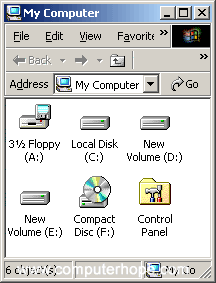How To Show C Drive In Windows 10
How to see all drives available on the estimator
Updated: 07/06/2021 by Figurer Hope
Note
This page provides data on how to determine which drives and drive letters your computer uses currently. Information technology is non a list of all of the possible drive letters.
See drives in Windows eleven, 10, and 8
If you're running Windows 11, Windows 10, or Windows eight, you can view all mounted drives in File Explorer. Yous can open File Explorer past pressing Windows key+E. In the left pane, select This PC, and all drives are shown on the right. The screenshot shows a typical view of This PC, with 3 mounted drives.

OS & Primary Software (C:)
In our first case, the C: and F: drives are hard drives, listed as primary and secondary. Almost computers only take a C: drive. The hard drive is the primary location where all files are stored on your reckoner. To open the bulldoze, double-click the drive.
Tip
In our case, the drives are labeled "Local Disk" and "New Volume." A hard drive can exist labeled anything and may be different on your reckoner. For steps on changing the name of your bulldoze, meet: How to rename or characterization a deejay bulldoze.
DVD RW Drive (D:)
The D: drive in this example is the optical disc bulldoze installed in the computer. In about situations, the disc bulldoze volition be the final drive letter of the alphabet. If a disc is in the drive, the contents of that disc are shown if you double-click the bulldoze icon.
How to locate an External hard drive, memory bill of fare, or USB Bulldoze on your computer
Every bit long as an external hard bulldoze, memory card, or USB bulldoze is connected to the figurer or on your network, they should announced in File Explorer. The external drive or USB will commonly be labeled as "external hard drive", "USB Drive", or has the manufacturer of the bulldoze listed in the bulldoze name.
See drives in Windows 7 and before

Microsoft Windows 7, Vista, XP, and earlier users tin can identify which drives Windows has detected by opening File Explorer and and so My Estimator, or pressing the Windows key+E shortcut key. The picture is an example of My Computer. As you tin can see in this example, 3 different bulldoze types are listed.
Tip
In Windows 7 and earlier versions, y'all tin access My Reckoner (Estimator) by double-clicking the icon on the desktop. Or, open the Start carte, and select My Computer or Computer, depending on the version of Windows you're using.
3 1/2 Floppy (A:)
If the calculator has a floppy disk drive, this drive is visible and usually set as the A: drive. If any floppy diskette is in the computer and the A: bulldoze is opened, its contents are shown.
Local Disk (C:), New Volume (D:), and New Volume (E:)
Next, in our example, the C:, D:, and E: drives are difficult drives or hard drive partitions on the computer. Most computers simply have a C: drive. The difficult bulldoze is the main location where all files are stored on your computer.
Tip
In our example, the drives are labeled "Local Disk" and "New Volume." A difficult drive tin can be labeled anything and may be unlike on your reckoner. For steps on changing the name of your drive, encounter: How to rename or label a disk drive.
Compact Disc (F:)
Finally, the F: drive in this case is the optical disc drive installed in the computer. In well-nigh situations, the disc drive is the last drive letter of the alphabet. If a disc is in the drive, the contents of that disc are shown if you double-click the bulldoze icon.
Tip
If the bulldoze AutoPlays the disc, right-click the drive, and click Explore.
Meet drives in Windows three.0, 3.1, and 3.11
Windows three.0, 3.i, and 3.11 users tin can open drives through the Windows File Manager. In the File Manager, click the drive icons shown above the binder and files. By default, the C: drive will be open up. If you want to movement to the floppy disk drive, click the A: drive icon. If y'all're going to open up the CD drive, click the D: CD-ROM drive icon.
Encounter drives in MS-DOS and the Windows command line
Windows Vista and afterwards control line users
If you're using Windows Vista, 7, eight, 10, or 11, utilize the wmic control at the Windows command line to view bachelor drives on the reckoner. At the prompt, blazon the post-obit command.
wmic logicaldisk become name
Or, for a picayune more data, such as volume size, utilize this control:
wmic logicaldisk list brief
Other Windows control line and MS-DOS version users
Unfortunately, there is no easy way to listing all available drives on the reckoner through the MS-DOS prompt with one control. Below are dissimilar recommendations for viewing drives.
Change drive letter
Change the bulldoze to an alternate drive letter to make up one's mind if a bulldoze is available and ready if no error message is received.
Fdisk
Running the fdisk control allows y'all to view how the hard drives are prepare and configured on the computer. However, this command is just possible if you're running a version of MS-DOS or Windows that supports fdisk.
vol
Running the vol command on a drive displays the drive characterization and serial number if available. This command allows you lot to see what drives are detected.
See drives in the Apple macOS
From the menu bar, select Go, then select Calculator, or printing the Shift+Command+C keyboard shortcut.
You can also view all drives through the Finder application.
Come across drives in Linux
Linux users can use the fdisk command to see their partition and bulldoze information.
Source: https://www.computerhope.com/issues/ch000854.htm
Posted by: nixonyones1946.blogspot.com

0 Response to "How To Show C Drive In Windows 10"
Post a Comment